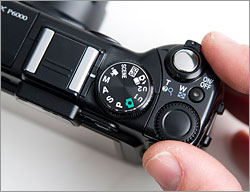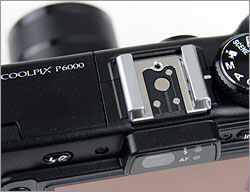Nikon Coolpix P6000 Camera Experience
I feel that there are two realms of performance with the P6000: interacting with the interface and shooting with the camera. The former is about using the device to prepare for shooting or to review photographs. The latter is about actually making pictures. My experience interacting with the P6000 is excellent. My experience shooting with the P6000 is mostly the same as it was with the P5100 (i.e., autofocus speed and shot to shot speed appears to be unchanged if not a little slower). In other words, shooting is adequate for static subjects, but less responsive for moving subjects or low light situations.
 Nikon’s button layout and thumb-controlled Command dial are intuitive and easy to operate. They’re very DSLR-like in a good way. The number of button presses to set a function is kept to a minimum, and it’s easy to return to your shooting mode quickly. The menus are bright and intuitive as well. However, I don’t understand why Nikon didn’t grey-out menu options that aren’t available in the camera’s current mode-options appear on the menu as if selectable but are simply skipped over when turning the control dial. This makes it hard to tell which features are active or inactive while in your chosen shooting mode. This can be frustrating.
Nikon’s button layout and thumb-controlled Command dial are intuitive and easy to operate. They’re very DSLR-like in a good way. The number of button presses to set a function is kept to a minimum, and it’s easy to return to your shooting mode quickly. The menus are bright and intuitive as well. However, I don’t understand why Nikon didn’t grey-out menu options that aren’t available in the camera’s current mode-options appear on the menu as if selectable but are simply skipped over when turning the control dial. This makes it hard to tell which features are active or inactive while in your chosen shooting mode. This can be frustrating.
Increasingly with compact cameras certain features or functionality disable other features or functionality. This makes it difficult to remember if and when the camera will function as you expect. Apparently this happens when more processor intensive features are activated. Features like D-Lighting or distortion correction or RAW format disable things like continuous shooting capability. In general this is understandable. But in practice it adds to camera frustration because you have to remember those limitations when trying to capture a shot. For instance if you’re shooting people candidly in somewhat backlit scenes and you want D-Lighting to open up the shadows, loss of continuous shooting requires the camera to refocus for each shot, significantly limiting the camera’s shot-to-shot speed.
If you like D-Lighting (Nikon’s in-camera contrast masking, which lightens shadows while maintaining highlights) after shooting a picture, then the P6000′s in-camera feature is well designed. You pick the image you want to apply D-Lighting to and then you’re shown the effect in low, medium, and high settings. When you make your choice, a new, processed picture file is copied from the original to the memory card. This is very handy for touching up snapshots. Active D-Lighting is now available, too. D-Lighting was previously only available as an in-camera post-processing tool. With Active D-Lighting you can have it automatically applied as you take photos.
On the other hand, Nikon constantly seems to be angling for dubious competitive advantages, and for some reason this maladaptive corporate behavior rears its ugly head yet again in the P6000. This typically takes the form of some camera feature announcement that appears to be useful at first but then you discover it has some asinine limitation leaving you to wonder, “what were they thinking?” The trend here is obvious and disappointing.
First was the announcement of the P6000′s “new” NRW RAW format, only compatible with Nikon software. Nikon fans know Nikon’s post-processing software hasn’t been a bright spot with avid photographers, let alone the general camera public. But since Adobe quickly added the P6000 to its Camera Raw compatibility, this is less of an issue. Our P6000 studio tests were all shot RAW and then converted to JPEG with Adobe Photoshop Lightroom 2.
Then there is the Ethernet feature. Or rather, there isn’t Ethernet. If you thought you’d be doing blazing fast file transfers from the P6000 to your computer – you were wrong. The P6000′s built-in Ethernet port is only for those who join up with Nikon’s “my Picturetown” online photosharing service. I must admit that this may be a savvy move for targeting the consumer who hasn’t yet joined Flickr, MySpace, Facebook, SmugMug, or whatever. On the other hand, I wish the engineering time that went into adding an Ethernet port and building the my Picturetown site was spent on improving the P6000′s auto focus and shutter-lag so it can compete other compact cameras.
 I might be in the minority here, but when I see a flash hot shoe I think “Great! I can use my third-party flashes and Pocket Wizard radio slaves to trigger more lights!” Unfortunately, the P6000′s hot shoe only works with Nikon Speedlites. Otherwise the “accessory shoe” is where you mount the P6000′s expensive optical viewfinder so you can look like a rangefinder shooter. Most film cameras and many digital cameras that have hot shoes will work with any flash. You may not get intelligent TTL flash metering with third-party equipment, but at least your flash should fire in manual mode and radio slaves like Pocket Wizards should work. Removing or limiting functionality that is a de facto photographic standard is shortsighted on the part of Nikon, to say the least.
I might be in the minority here, but when I see a flash hot shoe I think “Great! I can use my third-party flashes and Pocket Wizard radio slaves to trigger more lights!” Unfortunately, the P6000′s hot shoe only works with Nikon Speedlites. Otherwise the “accessory shoe” is where you mount the P6000′s expensive optical viewfinder so you can look like a rangefinder shooter. Most film cameras and many digital cameras that have hot shoes will work with any flash. You may not get intelligent TTL flash metering with third-party equipment, but at least your flash should fire in manual mode and radio slaves like Pocket Wizards should work. Removing or limiting functionality that is a de facto photographic standard is shortsighted on the part of Nikon, to say the least.
As always, the camera’s main task is helping you get the shot. This comes down to speed, accuracy, and consistency of key performance systems like auto focus, exposure metering, and image processing. Overachieving compact cameras and all digital SLRs go the extra step of capturing in bursts and/or writing data rapidly to the card. The P6000 really falls short here. For testing, I shot mostly RAW+Fine JPEG. This slows the camera down considerably. But even when shooting RAW only, the camera is useless between shots, while data is being written. I couldn’t detect any speed improvement comparing the P6000 to the P5100. Even the Sigma DP1, a real throwback in camera design if there ever was one, has a usable burst mode for capturing candid moments.
Many photographers think a live histogram is critical for getting accurate exposures. The P6000 doesn’t offer this feature – but I’m not sure I really missed it. Compact cameras that do display a live histogram often do so with all the other camera settings displayed. So using the histogram is a trade-off between exposure and composition since so much clutter appears onscreen. In my opinion, it’s better to test the camera for overexposure limits and just stay within those limits when shooting with RAW format. Besides – for most photos, it’s pretty easy to check the histogram after you shoot and reshoot if you didn’t nail the exposure.
Battery life is an important part of the user experience with any camera. If your camera batteries die on you all the time, you’re not going to be a happy photographer. I didn’t do any measurements but my impression of the P6000′s battery life is that it’s average to slightly below average for how I shoot and review. Normally this wouldn’t bother me much but for the fact that the P6000 ships with no external battery charger – battery charging is in-camera only. This wouldn’t be a problem for casual use, but if you’re traveling and shooting a lot, this could be a real problem.
next page – Nikon Coolpix P6000 Image Quality >>


Why even sell a camera with slow focus, slow write speed, slow lens, bad manual focus, built-in charger (it is always the first to break) and a high price for all this?
I own three Nikon DSLR’s and two film SLR’s but my two P&S are Canon. They mostly get it right. I would like to be an all Nikon family but my only P&S is a 5600 which is terrible. I have a broken 950 in the closet that was the closest thing to a perfect P&S from Nikon.
Hey guys… how about asking us what we want then engineering something to fit our desires?
Someone recently posted these instructions for using radio triggers with the p6000: that might address one concern:
1. In Flash Control option, turn built-in flash to off
2. At Multi selector, turn flash always on.
3. Now yur flash/trigger mounted on the hot shoe will be working…